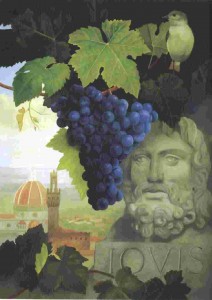 Last week’s column on the story of the Chianti Classico rooster was just the beginning of my exploration of the colossal offerings of the prolific Italian wine region.
Last week’s column on the story of the Chianti Classico rooster was just the beginning of my exploration of the colossal offerings of the prolific Italian wine region.
With more than 27 percent of the region’s sales occurring in the United States, you would expect U.S. consumers to have a good understanding of this region.
There is some confusion, though, likely the result of the sheer immensity of Italian wine offerings.
The primary grape of the Chianti region is the sangiovese, which flourishes on the Tuscan hillsides between Florence and Siena.
Chianti Classico must contain a minimum 80 percent sangiovese, and during my visit many Chianti producers expressed a shift to 100 percent — known as “pure” — to truly showcase the spirit of the sangiovese grape. Other grapes, such as the local canaiolo and colorino or cabernet sauvignon and merlot, can be added. Traditionally the white grapes trebbiano and malvasia were used, but since 2006 they are no longer allowed.
Chianti Classico wines have two distinct styles: the Vintage Year (annual) and Riserva (reserve). The vintage year is a fresh, fruity wine meant to be consumed young. A riserva is much different and strikes a balance between elegance and potency. Riserva wines are aged to provide the finest expression of sangiovese with its full-bodied, complex style. To qualify as a riserva, strict standards must be met, including a minimum of 12.5 percent alcohol, maturation for a minimum of 24 months with at least 3 months in the bottle before going to market.
THE VALUES
- 2008 Castello di Monastero Chianti Classico, Italy (about $24 retail)
- 2008 San Jacopo Chianti Classico, Italy (about $21 retail)
- 2009 Banfi Chianti Classico, Italy (about $15 retail)
- 2008 Cecchi Chianti Classico, Italy (about $18 retail)
THE SPLURGES
- 2008 Villa Antinori Peppoli Chianti Classico, Italy (about $32 retail)
- 2008 Dievole Chianti Classico Riserva, Italy (about $64 retail)
- 2008 Melini Terrarossa Laborel Chianti Classico Riserva, Italy (about $32 retail)